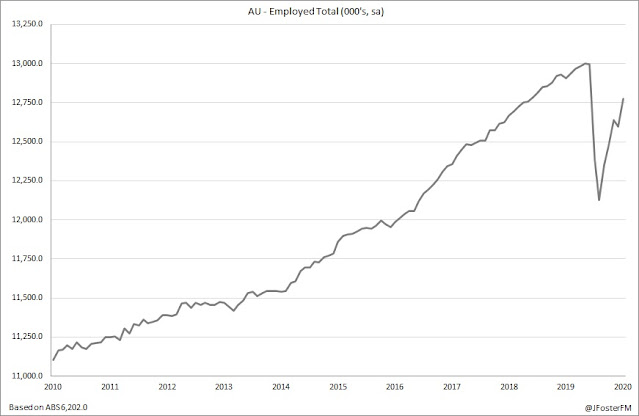After stalling in September, Australia's labour market regained momentum in its recovery from the Covid-19 pandemic in the month of October boosted by the anticipation of reopening in Victoria ahead of the easing of restrictions. Employment surged higher and hours worked also lifted sharply, while participation in the labour force is now close to where it was pre-pandemic.
Labour Force Survey — October | By the numbers- Employment (on net) came in very strong rising by 178.8k in the month to defy market expectations for a fall of 27.5k. September's initially reported fall of -29.5k was revised to a larger decline of -42.5k.
- The national unemployment rate lifted by 0.08ppt to 7.0%, though the median estimate was for a larger rise to 7.2%.
- Australia's participation rate surged higher by 0.95ppt to 65.8%, whereas it was forecast to hold at 64.8%.
- Total hours worked accelerated by 1.2% over the month to 1.711bn hours coming off a broadly flat outcome in September (0.2% revised from 0.5%) to pare the pace of decline through the year to -3.4% from -4.9%.
Labour Force Survey — October | The details
Certainly, today's report came as a major surprise. After a soft report in September that indicated the national recovery in the labour market was losing momentum with Victoria in shutdown mode and signs that the initial reopening surge could be fading in some of the other states, October's report blitzed even the most optimistic forecasts. The explanation behind today's strong report appears to be that businesses in Victoria anticipated the reopening and planned accordingly before restrictions had been meaningfully eased, which did not occur until the period between the back end of October into early November and this falls outside the reference period for this survey. Total employment surged by 178.8k and consisted of a 97.0k rise in full-time employment and an 81.8k lift in the part-time segment. Victoria contributed 81.6k jobs to the national figure, which more than recovered the 76.7k jobs that were lost over the preceding two months. However, employment nationally is still 1.7% below its pre-pandemic baseline, while Victoria significantly lags at 4.1% below baseline reflecting the impact of its recovery being derailed by the second shutdown.
With Victoria coming back online, hours worked were boosted sharply higher. Total hours worked increased by 1.2% in the month, with gains in both full-time (1.2%) and part-time hours (1.4%). Notably, part-time hours are broadly back to their pre-shutdown level, whereas full-time hours are still sharply below where they were in March. Total hours are down 3.8% on their pre-pandemic level, which is much more than where the fall in employment currently sits (-1.7%).
This next chart shows the evolution in hours worked across the states since the onset of the pandemic. In October, hours worked surged in Victoria (+5.6%m/m) off a low base, while Queensland lifted (+2.2%) to be above baseline, and Tasmania (+0.9%) also advanced. The other states softened, with New South Wales -1.7%, South Australia -0.4%, and Western Australia -0.5%.
With total hours much higher in October, levels of spare capacity in the labour market were reduced. The rate of underemployment (counting those employed but wanting more hours) fell from 11.4% to 10.4% and underutilisation (including both the unemployed and underemployed) declined from 18.3% to 17.4%. Both are still extremely elevated, but the direction of travel is encouraging. But, despite the big rise in employment and strength in hours work, the unemployment rate moved higher in the month rising from 6.9% to 7.0%, which reflects the impact of a very large rise in participation from 64.8% to 65.8%. In particular, participation in Victoria surged by 2ppts to around 65% due to the anticipation of reopening.
Overall, the national participation rate is now just about back to where it was before the pandemic hit. But with spare capacity elevated and with the share of Australians in work as a percentage of the population still a long way off its pre-pandemic level, this highlights just how important it is to keep employment growth rolling and justifies the recent policy actions by both the RBA and Federal Government.
Labour Force Survey — October | Insights
There were plenty of encouraging signs in today's report as the anticipation of reopening in Victoria saw the recovery in the national labour market regain momentum after stalling in September. However, there is still a long way to go in the recovery in terms of restoring employment and more so hours worked, and with participation already back to around pre-pandemic levels that process is likely to take a while yet.










